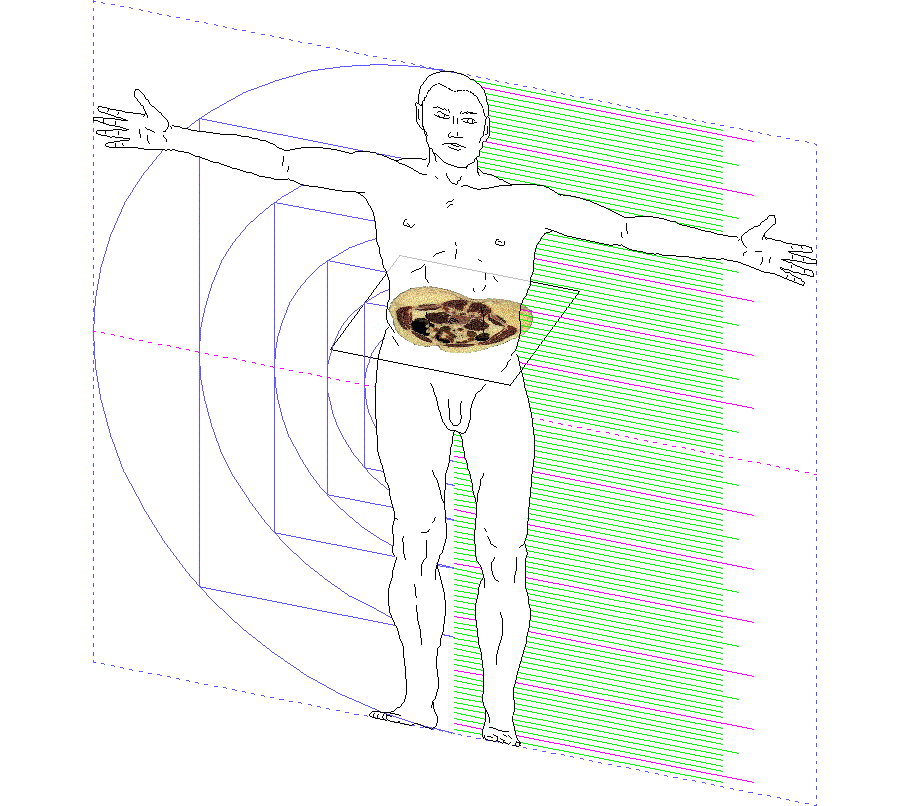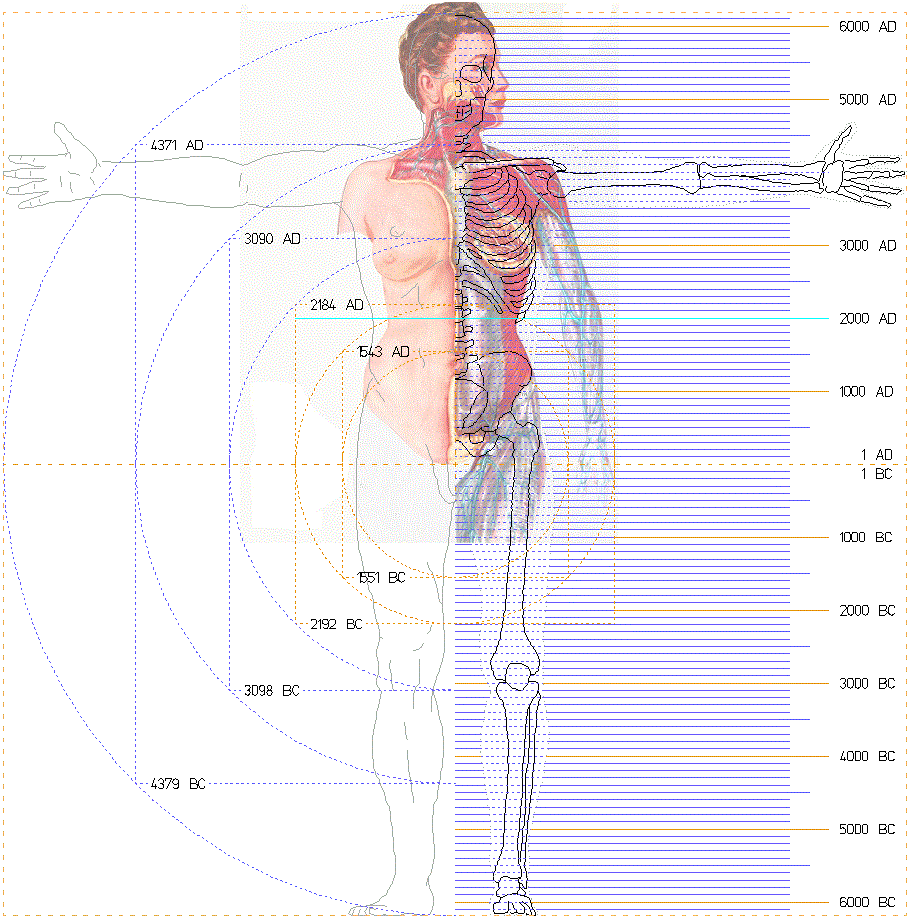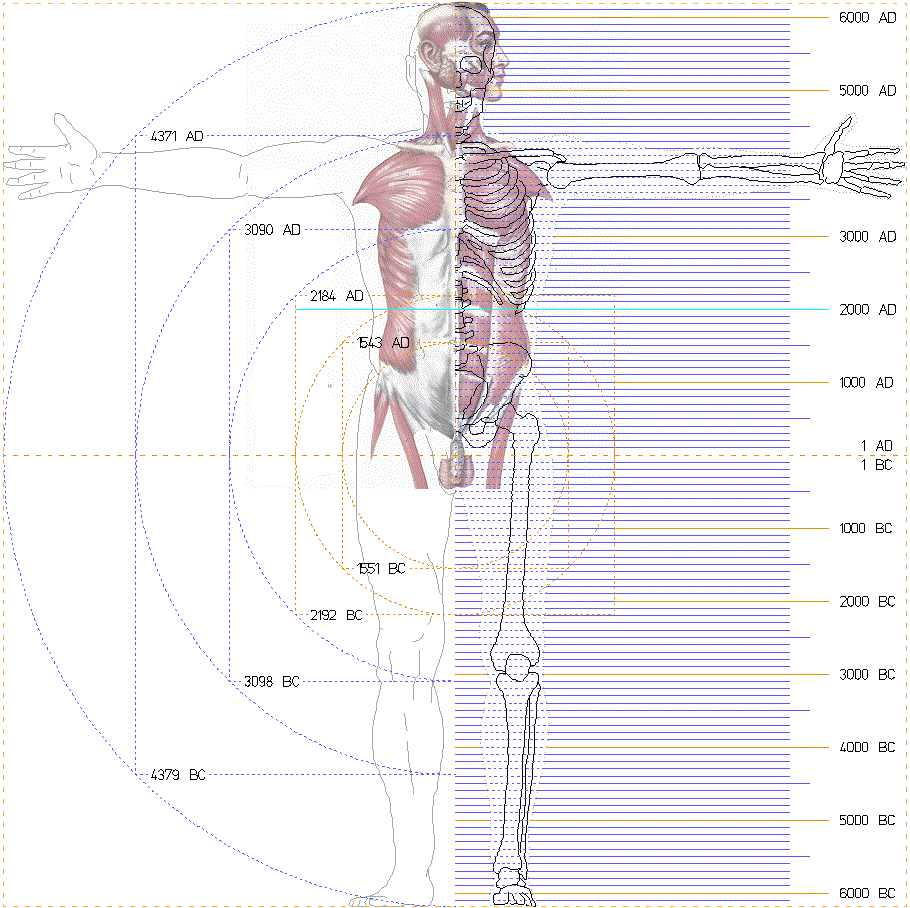2023.12.01
The first six chapters of The Timepiece of Humanity are available at www.quondam.com/44. (The web pages there were designed for viewing on a wide computer screen, and, thus, not phone reader friendly.)
The seventh chapter of The Timepiece of Humanity, "(chronosomatically) Contemplating the Navel," is available at www.museumpeace.com/17. (Again, the web pages are not phone reader friendly.)

The Timepiece gauge with the plane of the present positioned at anno 1543 and manifesting the transverse section of the male body through the navel.
An eighth chapter, "The Present," was planned, but barely got started. "The Timepiece of Humanity/Star Vengeance" is now the eighth chapter, and is indeed all about the present, specifically 21 April 2023 to 20 April 2024.
[unedited night note]
Every human alive between 21 April 2023 and 20 April 2024 is within the plane of the present (to be) discussed and portrayed within "The Timepiece of Humanity/Star Vengeance." And, the 21 April 2023 to 20 April 2024 plane of the present cuts through three superimposed human bodies: male, female and 4.85 months "second birth" fetus. I suspect I've been existing within the "second birth" fetus other.


1994.10.13
73.
...the physical manifestation of pregnancy manifests itself over time. A woman shows no sign of pregnancy at all in the early stages and in the late stages a pregnant woman reaches (exhibits) the largest cross sectional area that occurs in a human body. The key to reading the Timepiece in terms of pregnancy is to realize that the cross sectional area gets bigger as time goes on [--this originally relates to thoughts about the Timepiece 'portrayal' of population growth].
74.
The area of pregnancy spans in time from c. 770.7 A.D. (the placement of the uterus) to c. 3090 A.D.
This lends itself to an easy breakdown:
1 month = 1028 A.D.
2 months = 1285.5 A.D.
3 months = 1543.3 A.D.
4 months = 1801 A.D.
5 months = 2058 A.D.
6 months = 2316.7 A.D.
7 months = 2574.5 A.D.
8 months = 2832.2 A.D.
9 months = 3090 A.D.
1994.10.14
77.
In first openly discussing the population/pregnancy idea with Nancy Salmons, I came to the realization that between the years 770 A.D. and 3090 A.D., humanity is itself going through its own pregnancy. The pregnancy, of course, implies a birth and that birth will occur around 3090 A.D.--when the pregnancy runs its course and the plane of the present no longer slices through the region where pregnancy occurs. Now this idea leads to a number of questions.
What or who is the next major birth? Is it male, female, twins, triples, etc.?
Where exactly does pregnancy start (and end, for that matter)?
1994.10.22
110.
diaphragm - a body partition of muscles and connective tissues; specifically the partition separating the chest and abdominal cavities in mammals that by its contraction and relaxation varies the relative size and the internal pressure of these cavities and thereby plays an important role in such activities as breathing, defecation, and parturition and that in man has the form of an obliquely placed domed sheet, higher in front than behind, attached to the xiphoid cartilage, the six or seven lower ribs and their cartilage, and the lumbar vertebrae.
parturition - the action or process of giving birth to offspring.
1994.10.25
113.
The diaphragm's movements causes changes in pressure and changes in size of the abdominal and thoracic cavities. By this pressure change, the diaphragm plays an important role in breathing, defecation, and parturition (birth).
1994.10.27
124.
The end of the purge of humanity seems very significant because of the general negative connotations of purge. So with the end of purging being a function of humanity, it seems that a more positive time will begin for humanity. ...the purge of what is wasteful and harmful to the body, and, therefore, harmful to humanity.
125.
...address the role that the diaphragm plays in birth. This, of course, relates to the whole idea of pregnancy and the fact that the plane of the present passes through the area of pregnancy between the years 770 A.D. and 3090 A.D. The diaphragm pushes out the birth. This birth then occurs and coincides with the transition from metabolism to osmosis.
1994.10.31
126.
There is much discussion of a sacred "second birth" in The Sacred and the Profane.
1994.11.06
149.
Here is a list of all the parts of the body sliced through in the year 2000 AD:
abdomen muscles
colon transversum
colon ascendens and colon decendes obliquely
just beginning to slice through the stomach (lower portion)
just beginning to slice through the liver (lower portion)
very upper part of the intestine tenue
middle section of both kidneys
middle section of the duodenum
lower part of the pancreas
aorta and vasa cava inferior
the second vertebra below the lowest rib bones
I'm not sure at all what the combined picture of all these parts represents, but it does seem a bit overwhelming right now. I'm not sure after having done just this one century, if the Timepiece can afford to get this specific. It may be possible that the colon has the largest cross sectional area, esp. the colon transversum.
1994.11.30
214.
I'm not sure if I already mentioned this, but it is beginning to seem as if I could begin to describe a new sort of developed human being. I don't want to say a new "Ubermench," but in light of the heart and 100% osmosis (for example), it is very easy to imagine a type of human being that is different than we human beings are right now. With the heart and especially the neck, I have good reason to wonder if these points in the body are also future points of significant divine intervention and/or heightened human development.
1994.12.13
231.
In typing the notes pertaining to the century by century list of organs the present will pass through over the next 1200 years, it became evident that the height of plurality is still yet to come. Over the next few centuries, the present will actually pass through more organs than it presently does, and will actually climax at the most organs at about 2300/2400 AD. This provides insight into our present time. Our present is just the beginning of plurality. The major/upper organs of the digestive system will become the dominant organs in the "plane of the present." It seems that the immediate future will be a developing continuation of our present situation.
In general terms, the population will continue to increase, metabolism will become more and more the way things work, the plurality of organs (and perhaps then organizations) will become more and more evident, and what will by then by an over 2000 year tradition (assimilation) will be gradually, but evidently, leaving the picture.
The new tradition will be made up of a well defined plurality and a metabolism based operating system or imagination. There may also be a strong sense of anticipation for the coming second birth. The anticipation for the second birth will also be an anticipation for a whole new order.
1994.12.15
233.
Leslie Deis told me a few things concerning the end period of pregnancy and early child development. She said that she and other pergnant women exhibit a lot of energy especially right towards the end of their term. She also said that the first three months is when pregnant women get sick--in contrast to the energy recieved towards the end.
Now concerning early child development, Leslie told me about a book called The Magical Child. In it the author talks about how new born childern develope from the head down, i.e. at birth and immediately after, a child's head functions are pretty much 100%, the new borns can hear, see and smell pretty much perfectly. As time goes on and childern grow and develope, the arms become coherently operational and finally the legs (and walking) are the last to develope.
I have to admit that I am fascinated by this and I am not at all concerned or worried about development working from the head first and going down, as opposed to development working from the feet up (as in the Timepiece). It is indeed encouraging that The Magical Child relates development of the body in a sequential linear fashion.
1994.12.18
238.
In just skimming through Mircea Eliade's The Sacred and the Profane, I am finding all kinds of connections to The Timepiece of Humanity. In fact it seems as if I could find all the reinforcement for my story just in that book. Right now I am taking notes from the chapter entitled "Human Existence and Sanctified Life," especially where it concerns the "second birth."
239.
From: Mircea Eliade, The Sacred and the Profane, p. 195:
"...As we saw (Chapter 2), the cosmogonic myth is recited for therapeudic purposes. To be cured, the victim of an illness must be brought to a second birth, and the archetypal model of birth is the cosmogony. The work of time must be undone, the auraral moment immediately preceeding the Creation must be reintegrated; on the human plane, this is as much as to restore the "blank page" of existence, the absolute beginning, when nothing was yet sullied, nothing spoiled."
This passage brings very clearly to mind the way the heart and lungs predominate immediately after the second birth. The lungs themselves are organs that manifest the idea "when nothing was yet sullied, nothing spoiled." I myself have already, and repeatedly, referred to the era of the heart and the lungs as a whole new order, and this is the same as "...the auroral moment immediately preceding the Creation must be reintegrated."
This passage also contains the idea that "a second birth" is a cure for an illness. I'm not sure if this applies to the Timepiece, however I do see a distinct difference and contrast between metabolism and osmosis. The era of pluralism and metabolism may indeed seem like an illness when compared to the state of being within the realm of osmosis [and the heart/electo-magnetism].
The definition of cosmogony is the creation, origination, or manner of coming into being of the world or universe.
240.
From: Mircea Eliade, The Sacred and the Profane, p. 196:
"...Initiatery death reinterates the paradigmatic return to chaos, in order to make possible a repetition of the cosmogony--that is, to prepare for the new birth. Regression to chaos is sometimes literal ... This psychic chaos is the sign that the profane man is undergoing dissolution and that a new personality is on the verge of birth."
This passage introduces the idea od a death, a chaotic situation, a profane experiential that is necessary before "a second birth" A few things come to mind. One, the chaos may relate to the pluralism of the upper digestive system, and in turn, the era of metabolism may be a profoundly profane era. And second, I see the "new personality" as perfectly describing the whole new order manifested by the lungs and the heart.
241.
From: Mircea Eliade, The Sacred and the Profane, p. 197:
"The scenerio of initiation--death to the profane condidtion, followed by rebirth to the sacred world, the world of the gods--also plays an important role in highly evolved religions."
This passage further reinforces, and gives another name to, the transition from metabolism to osmosis. Along these lines metabolism = profane and osmosis = sacred ("world of the gods").
242.
From: Mircea Eliade, The Sacred and the Profane, p. 198-99:
"Sacred knowledge and, by extention, wisdom are conceived as the fruit of an initiation, and it is significant that obstetric symbolism is found connected with the awakening of consciousness both in ancient India and in Greece. Socrates had good reason to compare himself to a midwife, for in fact he helped men to be born to consciousness of self; he delivered the "new man.""
Of course obstetrics pertains to the whole nature of birth. In the Timepiece, I feel I am going a step beyond symbolism and relating the "second birth" directly to where pregnancy occurs within the human body. What isn't said by Eliade (and others) is the premire role of women after the "second birth," because it is the female body that will nurture the "second birth.' Plato can compare himself to a "midwife," but in actuality, no male can produce a birth.
243. (1994.12.18)
From: Mircea Eliade, The Sacred and the Profane, p. 201:
"From one religion to another, from one gnosis or one wisdom to amother, the immemorial theme of the second birth is enriched with new values, which sometimes profoundly change the content of the experience. Nevertheless, a common element, an invariable, remains. It could be defined as follows: access to spiritual life always entails death to the profane condition, followed by a new birth."
This is Eliade's conclusion to the topic of the second birth. Again it ties in perfectly with the Timepiece. My only reservation, thus far, is the negative idea of death, and in this case death to the profane. Is the era of metabolism really so profane, and likewise, is the era of osmosis so sacred? It is admitted simplistic to make the connection between metabolism/digestion and mundane/profane animal necessity, but are the workings of the lungs and the heart all that sacred? Or perhaps better put, are the working of the lungs and heart not also profane?
So far I do believe that there will be a great difference, on all counts, between metabolism and osmosis. And I even believe that osmosis is a positive step up from metabolism. I'm just not sure that the transition, facilitated by the dividing and functioning force of the diaphragm, that mankind will go through is actually going to be a transition from the profane to the sacred.
1994.12.29
255.
Here are the footnotes in my Bible to Revelation Chapter 20:
a. A thousand years: not to be taken literally. It signifies that, after the destruction of hostile kings and the chaining of the dragon, the Church will enjoy a long era of peace. During this era Christ will reign over the souls of man, and Christians, through their influence over the world, will reign with Christ.
Now I say that the thousand years can be taken (almost) literally, and I can also say that I have already drawn the same conclusions about the long era of peace enjoyed by the Church (see note 185). And the reigning of Christ over souls, and Christians reigning with Christ, very much support something similar to osmosis.
b. The rest of the dead: sinners who will not enjoy any kind of resurrection until the end of time. The first resurrection: the spiritual reign of the faithful with Christ during the long period of a thousand years. The general resurresction, on the last day is referred to in vv. 12 and 13.
There are a few other notes and one thing that is to be gotten out of the notes is how the Church is made synonymous with the references to Christ. This is almost to say that in the the future, from Saint John's point of view, that Christ is always represented as the Church, which I quess makes sense when considering the expression that the Church is the body of Christ.
1995.01.02
259.
...the new possible connection of Revelation and the Timepiece...
|